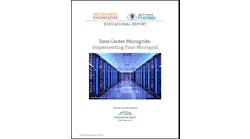Microgrid controllers are the talk of the industry because of their growing sophistication.
The best of them infuse genius into generators, batteries and other pieces of the microgrid that would otherwise be dumb and inflexible. Microgrid controllers can forecast, figure and optimize — faster than any human being – to leverage these assets.
But that’s not even the real “magic,” says Chris Clippinger, east region business development manager for SEL Engineering Services, a division of Schweitzer Engineering Laboratories.
“The ability of the controller to mesh together 10 or 15 different manufactured systems. That’s the magic,” said Clippinger in a recent interview. “This master controller has to be able to interface with all of these different technologies and make them hum like a sewing machine.”
This is important because microgrids often lack standardization.
Few are built all-of-a-one with a single company’s wares. Instead, a microgrid tends to be customized, put together by a team of companies whose equipment is chosen because it meets a specific requirement of the project.
Further, microgrids often aren’t built all at once. Many evolve over time, with new equipment added as the customer’s budget and energy needs change.
So the microgrid’s workings — generation, storage, inverters, wiring, switches, software — end up coming from various manufacturers. And they don’t necessarily all ‘talk’ the same language.
“If all of the components were manufactured by the same company that would simplify it,” he said. “But that’s typically not the case. There is a matrix of vendors that are involved. You’ve got to marry all of their communications into one cohesive brain.”
Creating this cohesion is a big part of SEL’s microgrid value proposition.
“We don’t make the batteries, we don’t make the flywheels, we don’t make the combustion turbines. SEL’s equipment is purely the brain, the microgrid processing protection and equipment,” he said. “We specialize in the hardware and software engineering and testing to ensure we marry together all of these third party systems and get them to work properly.”
Download a free case study about SEL’s microgrid controller project at the University of California, San Diego.
Safety first
Not only must the microgrid components work together, but they must do so safely. A former Duke Energy employee, Clippinger says he understands utility worries about interconnection to their systems
In the early days, “microgrids were actually shunned,” he said.
Customers had emergency generation, but it was isolated from the utility system. That’s changed dramatically with today’s rapid growth of grid-connected distributed energy.
To meet the need for safety in this new world, SEL conducts extensive pre-field testing of microgrid equipment with a real-time digital simulator in its Pullman, Washington headquarters. SEL emulates the power system and puts equipment “through its paces,” he said.
“That is a critical success factor in the work that we do. We are able to test the system thoroughly in that environment prior to it getting installed,” Clippinger said. “Of course, that doesn’t waylay the requirement for field testing. But it significantly minimizes it.”
Homeland security
Standardization and testing are becoming increasingly important as interest grows in microgrids. Clippinger sees several factors driving growth — state incentives, weather, environment, technology advancement. But the most powerful of them, he said, is homeland energy security, the grid’s ability to withstand terrorist attacks.
Distributing our energy supply, rather than centralizing it, offers a form of protection against such attacks. Or as Clippinger put it, “dividing a couple of gigawatt facilities by 400 is going to make any particular attack 10 fold more difficult.”
He added: “Maybe you replicate Texas and every state becomes its own microgrid in the event of a system disturbance or terrorist attack. That would make our infrastructure much more resilient and less prone to catastrophic failure.”
Whether state by state, company by company, or institution by institution, Clippinger sees the microgrid market growing rapidly. “The sky is the limit,” he said. “It’s clearly no longer if it is going to happen; it’s how quickly it is going to happen.”
For more information about SEL, please visit
Learn more about microgrid controllers by subscribing to the Microgrid Knowledge newsletter. It’s free.







